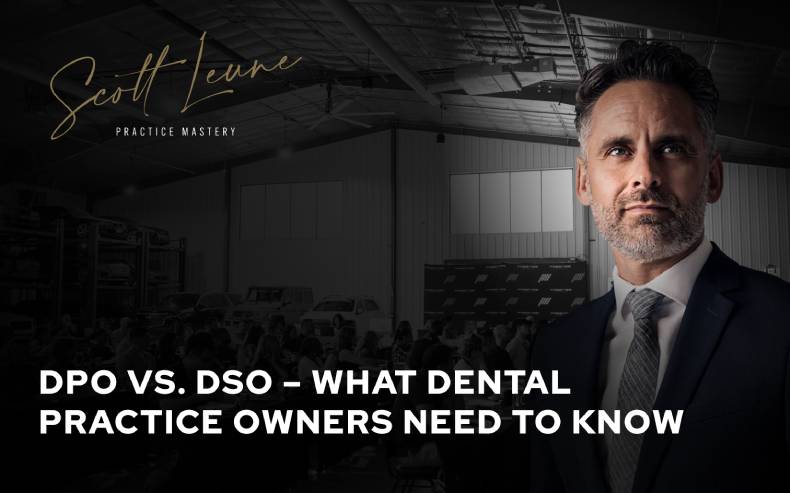DPO vs. DSO: What Every Dental Practice Owner Should Know
Thinking about the next step for your dental practice? Whether you’re eying expansion, an exit, or simply curious about today’s hottest dental practice trends, understanding the real differences between DPO and DSO could be the single most important financial decision in your career. For owners determined to maximize value and keep control, knowing what’s beneath the surface of these business types is critical, and your best defence against costly, irreversible mistakes.
Below, you’ll unpack not just what DSOs and DPOs are, but why the deal structures and market forces matter so much. You’ll also learn actionable steps to position yourself for the strongest outcome, based on real experience, not sales pitches or oversimplified summaries.
What is a DSO? (Dental Support Organization)?
DSO stands for Dental Support Organization. While that definition seems simple, the model has evolved dramatically. Early “DSO 1.0” was corporate, top-down, and notorious for limiting dentist autonomy. Decisions came from the “suits”, often with little respect for provider input. This legacy cemented a reputation for hostility, lost autonomy and a “sell-out” stigma many still remember.
The modern DSO (“DSO 2.0”) is different. Today’s leading DSOs emphasize provider-centric partnerships. They buy quality practices but let doctors keep clinical and operational decision-making authority. As a result, DSOs have become a popular transition option, especially for multi-locational or high-EBITDA practices that are difficult to sell in a purely private market. Private equity is deeply involved, funding those consolidations by offering higher valuations, at least on paper.
Pros:
- Higher potential sale price, especially for large multi-location practices
- Increased economic of scale and operational support
- Potential for dentists to stay involved and share in future profits (sometimes via equity or joint venture
Cons:
- Complex deal structures (cash, stock, holdbacks, and lengthy commitments)
- Loss of true ownership and, at times, day-to-day control
- Risk of predatory or “for free” sales where the seller’s own future labor funds the purchase price
What is a DPO? (Dental Partnership Organization)
A DPO, or Dental Partnership Organization, offers a different path. Think of it as a hybrid between full independence and outright corporate sale. The DPO model lets owners retain significant clinical autonomy and often a large equity stake at the practice level, all while accessing shared resources, technology, and management expertise.
Most DPOs operate on genuine partnership practices, not mere acquisition. Your upside is linked to overall group success, not just the fortunes of a distant parent company. This shared-skin-in-the-game structure can foster better alignment and long-term personal investment in the practice’s future.
Pros:
- Strong autonomy and decision-making retained at the doctor/practice level
- Participation in group growth and upside through joining venture equity or similar mechanisms
- Access to efficiencies, mentorship, and resources without losing identity
Cons:
- Not every practice is a fit. DPOs often target established, growth-oriented doctors
- Deal structures can still be complex, and value is closely linked to the partnership’s overall health
Factors to Consider When Choosing a DSO vs. DPO
Ownership and Autonomy
DSOs may promise “doctor-led” systems, but ultimate ownership, and strategic control, belongs to the parent company. DPOs, meanwhile, are structured for real partnership, usually allowing partner doctors to keep a genuine say in direction and management. If preserving control is a top priority, clarity on these terms is a must.
Financial Outcomes
The high EBITDA multiple associated with a DSO sale catches attention. But here’s the dirty secret: that headline number can be misleading. Many DSO deals require you, the seller, to commit to working in the practice for 3-5 years post-closing. The multiple only delivers a true financial win if the payout is heavily upfront, in cash, with little risk. Too often, sellers wind up locked into “golden handcuffs” where their own future labor effectively pays for the sale.
Additionally, stock components present significant liquidity risk. Shares in a private DSO parent can’t be sold on the open market and are subject to dilution and unpredictability with every recap. Earnouts and holdbacks, now more common as DSOs seek to preserve cash and align incentives, can dramatically reduce a seller’s true payout if future targets aren’t met.
Watch For:
How much is cash versus stock, and what’s your real path to liquidity?
What are the obligations after closing? Are you earning the practice’s value, or selling it?
Do you retain enough equity, or influence, to benefit from future growth?
Lifestyle and Stress
Many owners understand post-sale frustration. DSO deals frequently shift decision-making authority or impose system changes (from staffing to marketing to vendor contracts) that bring new stresses and take away self-determination. DPOs, by contrast, offer more stability and fewer unwelcome surprises, especially on clinical autonomy, because the partnership is structured with mutual incentives.
Practice Value and Timing
The biggest practice values are realized at the right time: when EBITDA is maximized, growth trends are positive, and the practice is positioned as a “class A” asset (multi-doc, strong infrastructure, positive location). Understanding these drivers, and preparing through annual valuation and clean financials, not just tax minimization, is critical. DSOs put a premium on large, healthy, and “transferable” practices, while DPOs are more interested in partnership fit and shared growth potential.
Long-Term Goals
For dental practice owners with a long career horizon, the benefits of a DPO often surpass those of a standard exit. A DPO’s shared upside structure, collaborative mentoring, and robust group infrastructure can build lasting value while supporting clinical autonomy and professional growth. This alignment builds greater satisfaction and more meaningful rewards compared to quick sale options that might prioritize rapid payout over sustained development.
Conversely, for owners focused on retirement or a transition, a DSO’s “walk-away” value, if coupled with the right deal infrastructure and adequate safeguards, can be appealing, allowing for a cleaner exit and financial windfall without the extended commitment associated with partnerships.
Staff Implications
Staff outcomes differ between DSO and DPO arrangements. In DPO settings, emphasis is placed on preserving practice identity and continuity, which leads to a stronger sense of team loyalty and cultural stability. Employees typically benefit from ongoing mentorship, a familiar environment, and long-term investment in their career. By contrast, traditional DSOs tend to introduce streamlined, corporate systems that can erode individuality, reduce clinical input, and make employment feel transactional. As a result, staff morale and retention rates often prove higher in DPO-affiliated practices where group culture and experience matter.
The Hidden Risks of Selling to a DSO
Navigating DSO deals isn’t just about chasing the highest offer, it’s about understanding hidden risks and ensuring every move maximizes practice value. Too often, owners fall victim to unseen pitfalls that impact their financial future in ways they didn’t expect.
Here are the powerful, but often overlooked, risk factors in DSO negotiations:
- Deal Fatigue: The process is grueling. Defending financials, negotiating terms, and managing due diligence alone leads many owners to accept last-minute “bombs”; massive, last-minute drops in sale price, just to get it over with.
- Unsolicited Offers: “Direct-to-doctor” deals almost always leave value on the table. Without competition, DSOs will start low, and most doctors don’t realize how much leverage they’re conceding by responding to the first call.
- Stock Over Cash: Taking stock in a holding company, instead of cash, adds huge uncertainty, especially with frequent dilution and no public exit plan.
- Employment Commitments: Every extra year required after the deal should reduce your effective sale multiple. If you have to stay five years, but only receive a 7x EBITDA payout, you’ve simply traded future earnings for someone else’s benefit.
- Control Lost: Once the practice is sold, doctors often find themselves lost out of key staffing, marketing, or vendor decisions, with new systems adding stress, not removing it.
A recent example underscores just how impactful these factors are. One practice owner received an unsolicited offer of $6.8 million, a number that seemed impressive at first glance. With formal representation and a competitive bid, the final sale price hit $9 million with the same DSO, a $2.2 million gap. That gap wasn’t luck. It was the direct result of avoiding the risks above: resisting deal fatigue, letting competition set the value, and refusing to accept the first, easiest path.
When a DSO or DPO Makes Sense
A DSO may be right if:
- The practice is exceptionally large, multi-site, and challenging to sell privately.
- You want a high upfront payout and are comfortable with a vesting period and new leadership.
- You have a strong EBITDA, multi-doctor coverage, and wish to reduce active management soon.
A DPO may be right if
- You value autonomy and want to retain partnership equity.
- Mentorship, shared growth, and clinical-decision making are priorities.
- Your practice has growth potential, but you’re not ready for a full exit
- You’re committed to long-term success and want to maintain your culture and team.
There’s no “one-size-fits-all”, but the right choice always aligns with your personal, financial, and lifestyle goals. Expert, specialized advice is essential to map this out and avoid mistakes that cost millions or years of regret.
How to Protect Yourself in Any Deal
- Never Respond Blindly to Unsolicited Offers: Always create competition. The first offer is rarely (if ever) the best.
- Clean Up Financials in Advance: Prepare years ahead. Remove discretionary expenses, clarify add-backs, and maximize true EBITDA.
- Demand Transparency and Detailed Valuations: Control the EBITDA narrative, don’t let the buyer set the story or undermine your value.
- Get Experienced Representation: Engaging advisors and attorneys who live and breath dental transitions can add millions to the final outcome and shield you from emotional and financial fatigue.
- Be Wary of Complex Deal Structures: Assess every element of the offer: cash, equity, earnouts, employment period. The simplicity of a 100% cash, walkaway deal is hard to beat, even if the headline number seems higher with contingencies.
Ready for Next-Level Guidance?
For those considering a DPO or DSO affiliation, or just wanting clarity about their practice’s true value, there’s no substitute for hands-on, real-world expertise. Don’t gamble your legacy, lifestyle, or financial future on stock offers and handshake deals. Instead, join the industry’s leading intensive event dedicated to dental excellence, ownership protection, and best-in-class deal outcomes.
To get an unfiltered perspective, watch Dr. Scott Leune’s full webinar on DSO affiliations and the complexities behind dental private equity, EBITDA, and maximizing practice sale outcomes. As a next step, deepen your understanding and safeguard your investment by enrolling in an upcoming Multi-Practice Mastery seminar, which provides data-driven guidance necessary to proceed with confidence.

